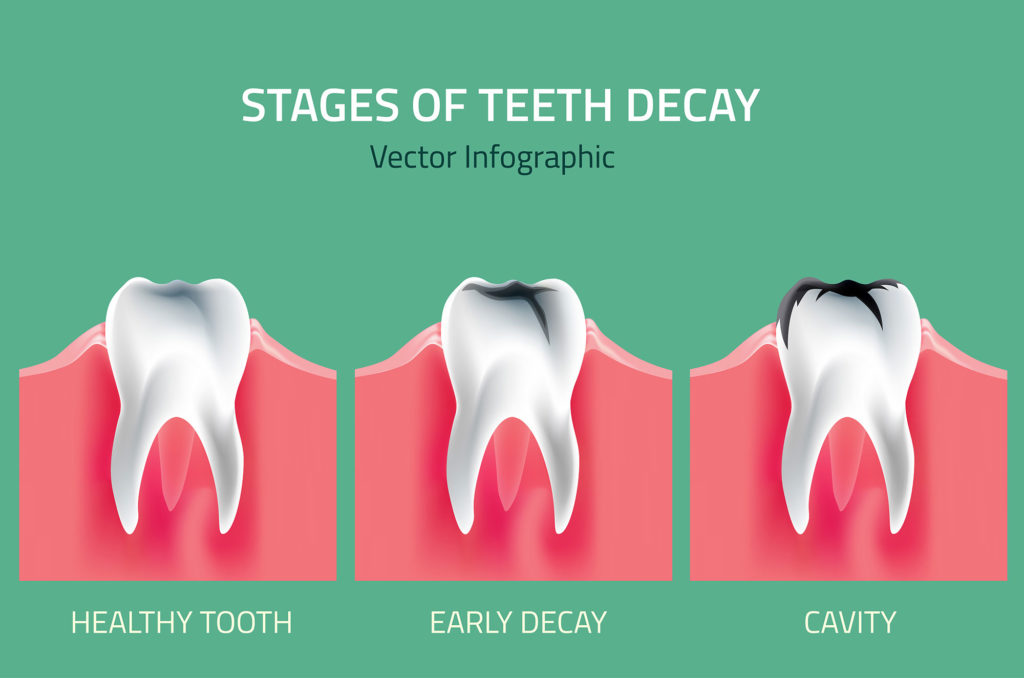Tooth decay is going to be damage that happens to the teeth. When it is not taken care of with the help of orthodontic care, it can result in a cavity that will need some more attention too. The earlier the tooth decay is found, the easier it is to fix and slow down. Your orthodontist will be able to look for some of the signs of tooth decay to help you get the necessary treatment to take care of your teeth.
Tooth decay has several stages that will happen and it is not a process that happens overnight. Some of the stages that your orthodontist will look for when it comes to tooth decay in the mouth includes:
The Initial Demineralization
During this stage, the bacteria that is found in plaque will start to go through the enamel of the teeth. This is the material that makes up the outer layer of the tooth. Enamel is a hard tissue that is made of a variety of other minerals, but as soon as the acids from plaque come in contact with it, the minerals will start to fade away.
This process can happen slowly. As the enamel begins to fade, you may start to see a white spot that appears on the teeth. This is a sign that minerals are being lost from the teeth and is one of the first signs you or your dentist will notice of tooth decay. An orthodontic treatment with your dentist will help you fix the mineral loss and make the teeth stronger.
Enamel Decay
With routine dental exams, the first step can be found relatively quickly and you can get the right treatment to help out the teeth. However, if you skip the routine checkups and the tooth decay is allowed to continue, then the enamel is going to break down even more. Over time, it is possible that the white spot seen earlier is going to darken into a brownish color.
As the enamel around the tooth starts to weaken, there can be some small holes that form in the teeth. These are known as cavities. Cavities can’t be healed on their own and you will need to visit a dentist to get it filled and to protect your teeth.
Dentin Decay
Dentin is going to be the tissue of the tooth that is right under the enamel. This material is softer than the enamel, which can make it more sensitive to some of the damage that happens with acid from plaque. Once the acid reaches the dentin, the tooth decay is going to happen at a faster rate.
When the acid and bacteria reach this part of the tooth, this is likely to be more pain that you will suffer. This is due to the fact that the Dentin is going to have tubes that lead to the nerves of the tooth. Your tooth may become very sensitive when the bacteria reaches this level. This is often easy to notice when you have hot or cold drinks and food.
Damage to the Pulp
The next stage in tooth decay is damage to the pulp. The pulp is going to be the innermost layer of each tooth. It will hold onto the nerves and the different blood vessels that are there to provide the tooth with nutrients to keep healthy. These are also the same nerves that will provide different sensations to the tooth.
When the tooth decay gets bad enough to damage the pulp, that area of the tooth can get very irritated and may swell. Because the tissues that are around the tooth are not able to expand to help accommodate this new swelling, it is likely that some pressure will be placed on the nerves, which will lead to pain.
Abscess
The final stage of tooth decay is known as abscess. As the tooth decay starts to advance into the pulp, the bacteria now has room to move around and invade that area. This leads to an infection in the tooth. An increased amount of inflammation in the tooth may lead to a pocket of pus forming right near the bottom of the tooth, which is then called an abscess.
These abscesses are going to cause a lot of pain, often enough that it radiates down into the jaw. There are a number of symptoms that you may experience when this happens including swelling in the jaw, face, or gums, a fever, or even swollen lymph nodes near the neck as the body tries to heal from the infection.
If the tooth decay gets to the point of an abscess, you need to receive orthodontic treatment right away. This kind of infection will eventually spread into the bones of the jaw and other areas of the head and neck. When the tooth decay gets to this point, the dentist may need to remove the affected tooth to let the area heal.
How to Prevent the Stages of Tooth Decay
Catching the tooth decay in some of the earliest stages is often preferable to letting it go and ignoring the problem. When the white spots appear in the enamel, it is much easier to add some fluoride treatment to the tooth to make it stronger compared to waiting until there is damage to the pulp or an abscess in the tooth that causes a lot of pain and can result in the tooth getting pulled out.
Good oral hygiene is the best way to prevent and stop tooth decay when it does happen. Brushing your teeth with an electric toothbrush and some fluoride toothpaste is a good start. Add in some flossing and a strong mouthwash and you can help to prevent the tooth decay. Routine visits to your orthodontist will help you look for some of the early signs of tooth decay and then can provide the right treatments to take care of it, long before an abscess or other options that can ruin your teeth and your smile.



